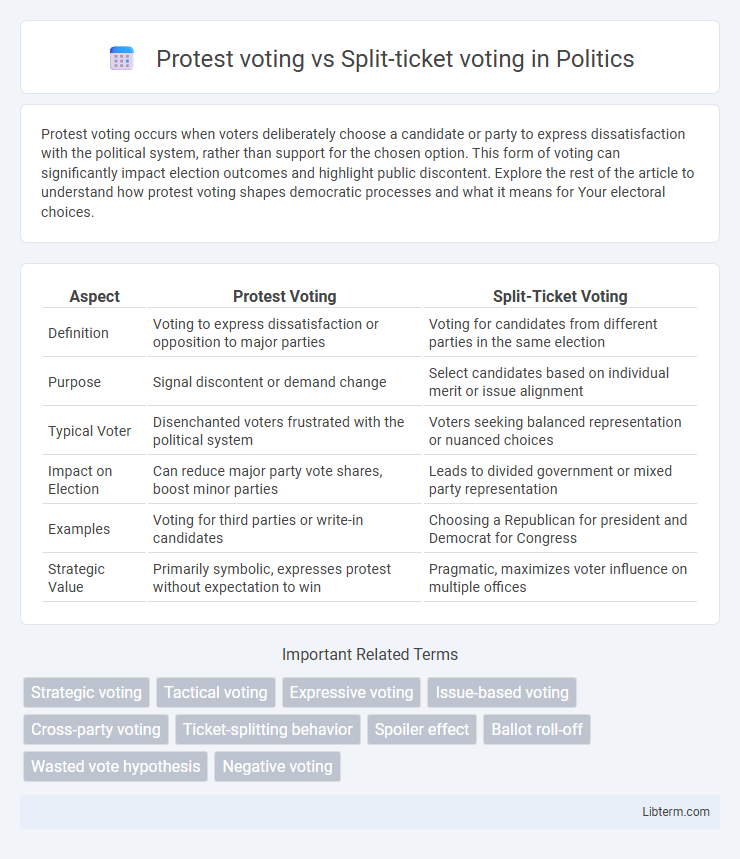Protest voting occurs when voters deliberately choose a candidate or party to express dissatisfaction with the political system, rather than support for the chosen option. This form of voting can significantly impact election outcomes and highlight public discontent. Explore the rest of the article to understand how protest voting shapes democratic processes and what it means for Your electoral choices.
Table of Comparison
| Aspect | Protest Voting | Split-Ticket Voting |
|---|---|---|
| Definition | Voting to express dissatisfaction or opposition to major parties | Voting for candidates from different parties in the same election |
| Purpose | Signal discontent or demand change | Select candidates based on individual merit or issue alignment |
| Typical Voter | Disenchanted voters frustrated with the political system | Voters seeking balanced representation or nuanced choices |
| Impact on Election | Can reduce major party vote shares, boost minor parties | Leads to divided government or mixed party representation |
| Examples | Voting for third parties or write-in candidates | Choosing a Republican for president and Democrat for Congress |
| Strategic Value | Primarily symbolic, expresses protest without expectation to win | Pragmatic, maximizes voter influence on multiple offices |
Understanding Protest Voting
Protest voting occurs when voters intentionally cast ballots for fringe or non-mainstream candidates to express dissatisfaction with the political system or major parties, serving as a symbolic rejection rather than genuine support. This form of voting highlights underlying voter discontent and can influence election outcomes by reducing the vote share of traditional parties. Understanding protest voting is essential for analyzing political engagement and the dynamics of voter behavior beyond policy preferences.
Defining Split-ticket Voting
Split-ticket voting occurs when voters select candidates from different political parties for various offices in the same election, reflecting a preference for individual candidate qualities over party loyalty. This behavior contrasts with straight-ticket voting, where voters choose candidates exclusively from one party, and protest voting, which often involves casting ballots to express dissatisfaction rather than genuine support. Understanding split-ticket voting reveals insights into voter independence, issue-based decision-making, and the complexity of electoral behavior in multiparty systems.
Key Motivations Behind Protest Votes
Protest voting primarily emerges from voter dissatisfaction with major political parties or candidates, signaling a rejection of the current political establishment rather than support for alternative policies. Key motivations include frustration over unmet expectations, lack of trust in political institutions, and a desire to express discontent without abstaining from the electoral process. Unlike split-ticket voting, which reflects nuanced preference across party lines for balanced representation, protest votes convey a broader critique aimed at prompting political change or accountability.
Factors Influencing Split-ticket Choices
Split-ticket voting is influenced by voter desire for balance in government, individual candidate appeal across party lines, and dissatisfaction with party polarization. Factors such as local issues, personal candidate attributes, and voter mistrust of party platforms drive split-ticket choices. Protest voting often signals voter discontent without specific candidate support, whereas split-ticket voting reflects nuanced decision-making based on multiple election elements.
Historical Trends in Protest and Split-ticket Voting
Historical trends reveal that protest voting, characterized by voters selecting fringe or anti-establishment candidates, surged during periods of political dissatisfaction, notably in the 1960s and 1970s civil rights and anti-war movements in the United States. Split-ticket voting, which involves casting ballots for candidates from different parties in the same election, peaked in the late 20th century, especially in the 1980s and 1990s, reflecting increasing voter independence and polarization. These patterns demonstrate an evolving electorate responding to political realignments, with protest voting signaling discontent and split-ticket voting indicating nuanced voter preferences.
Impact on Election Outcomes
Protest voting often reflects widespread voter dissatisfaction, potentially decreasing support for major parties and increasing the success of fringe or third-party candidates, thereby altering traditional election dynamics. Split-ticket voting, where voters select candidates from multiple parties on the same ballot, can weaken party dominance, encourage more moderate candidate platforms, and lead to divided government outcomes. Both voting behaviors significantly influence election results by reshaping party competition, voter representation, and legislative balance of power.
Demographic Profiles of Protest vs. Split-ticket Voters
Protest voters often include younger, less politically engaged individuals and those from lower socioeconomic backgrounds who express dissatisfaction with the political establishment by casting votes for fringe or third-party candidates. Split-ticket voters tend to be more educated, older, and politically experienced, showing nuanced voting behavior by selecting candidates from different parties across various offices. Urban and suburban demographics are more likely to exhibit split-ticket voting, while rural areas have higher proportions of protest voters.
Political Party Responses to Voting Patterns
Political parties analyze protest voting as an expression of voter dissatisfaction, prompting shifts in policy platforms to recapture disillusioned electorates. Split-ticket voting signals voter desire for balanced governance, encouraging parties to moderate partisan rhetoric and pursue bipartisan cooperation. Both voting patterns force political parties to reassess candidate selection and campaign strategies to better align with evolving voter preferences.
Case Studies: Protest Voting vs. Split-ticket Voting
Case studies reveal that protest voting often emerges in scenarios of political dissatisfaction, where voters express dissent by supporting fringe or non-mainstream candidates, as seen in the 2016 US presidential election. Split-ticket voting is prevalent in more stable democracies like Germany, where voters deliberately choose candidates from different parties for executive and legislative branches to balance power. Empirical data from these cases highlight that protest voting signals political discontent, whereas split-ticket voting reflects strategic decision-making to influence governance outcomes.
Implications for Democratic Processes
Protest voting, characterized by casting ballots for fringe or non-establishment candidates, signals voter dissatisfaction and can pressure mainstream parties to address neglected issues, potentially enhancing democratic responsiveness. Split-ticket voting, where voters choose candidates from different parties for different offices, promotes candidate-centered elections and encourages political diversity, reducing partisanship and fostering a more balanced representation. Both voting behaviors influence democratic processes by challenging party dominance and stimulating political competition, which can lead to increased accountability and policy innovation.
Protest voting Infographic

 libterm.com
libterm.com